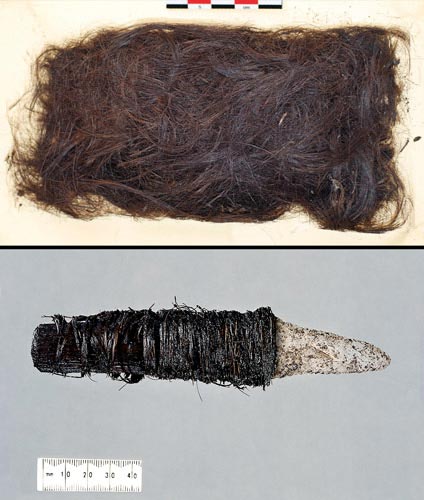Prehistoric hair shows the first Eskimo from Asia
The new study shows that a handful of frozen human hair discovered in northwestern Greenland is proof that the first Eskimos in the New World are not native American breeds as people think but come directly. from Asia.
Moreover, the pioneering northern settlers were later extinct and did not produce the Inuit people living in Greenland today.
The work is based on an analysis of the ancient hair of the ancient Eskimo group, preserved in the permafrost in the Disco Bay area in the 1980s.
The pinch of hair - belonging to a man who lived 4,000 years ago - provided the first complete mitochondrial genome to the ancients, according to archaeological group led by Tom Gilbert of the Center for Ancient Genetics. at the University of Copenhagen, Denmark.
Mitochondrial DNA is passed from mother to child, thus giving the genetic background of an individual's mother's ancestors.In the case of the ancient Eskimo Greenland, his hair revealed that his tribe came from Siberia . Ancient Eskimo genetic relatives today have only a few in northeastern Siberia and Aleutian islands, extending the Bering Sea from Alaska to Russia.

The first Eskimos to occupy the non-Native American New World were not the ancestors of the Inuit today, according to an ancient hair-based DNA study in Greenland.Archaeological studies link the first Eskimos in Greenland to the Saqqaq culture, appearing 4,500 years ago and using lightweight tools such as knives and tubing.Today's Inuit ancestors have replaced their place.(Photo: Bjarne Grønnow)
Bold hypotheses
Previously, there were two main theories to explain the first Eskimo ancestors in Alaska, Canada and Greenland.
These theories suggest that they are either descendants of Native Americans who settled in North America at least 14,350 years ago, or they came from a similar region in Siberia and gave birth to modern Eskimo, like those lived in Greenland for the past 1,000 years.'Then there is a third idea that they are not both groups of people - and indeed it is.'
The work appears in Science, suggesting that the ancient ancient Eskimo of the New World was replaced by later settlers who traveled east from Siberia . 'There may have been groups of people along the road from Alaska to Greenland, but then all disappeared and many others appeared. A separate wave of migration created the modern Inuit. '
Archaeological works link the first Eskimos in Greenland to the Saqqaq culture, appearing 4,500 years ago while the later Thule culture only appeared 1,000 years ago.
The tools belonging to these two groups are very different. For example, Saqqaq's hunting tool is described as 'needing bait' if compared to the later bulky tool.
'Saqqaq culture is very different, with elaborate tools and elaborate manufacturing such as light weight tuberculosis and small fishing hooks.' Greenland's archaeological transformation is now underpinned by new DNA evidence.
The extinction of the ancient Eskimo
Peter Forster, archaeological researcher at Anglia Ruskin University, USA - who is not involved in the new work - thinks archaeologists are unanimous ' perhaps the ancient Eskimo was extinct but there was no way. Which proves it. ' So the most recent finding 'is a great demonstration' and 'solve an ongoing scientific debate'.
The pronounced DNA traces of frozen hair were consistent with Forster's own study, showing that no ancient Eskimo lineage was present in the population of Greenland today . 'I feel very satisfied because it coincides with what we expected.'
The main study of Gilbert and colleagues suggested that ancient Eskimo groups could not withstand the cold weather.'Clearly, the environment in this region is extremely harsh, so that the population shrinks and disappears.' Forster agrees, adding that the disappearance of the ancient Greenland Eskimo coincided with the cold earth event culminating in 2,800 years ago.
Similarly, a later cold period, known as the Little Ice Age, lasting from 1350 to 1850 AD, is thought to wipe out the genetic traces of the first European settlers in Greenland, Viking.
- Discover the ancient village of Eskimo under the ice melting in the Arctic
- 50 The incredible truth about hair
- Why silver hair back?
- The cure for silver hair does not require dyeing
- Why do dirty hair get better?
- The concept of women possessing naturally curly hair is very difficult, is this true?
- 47-year-old teacher died after 10 days of dyeing her hair
- Prehistoric people painted animals more beautiful than modern people
- Found giant shark teeth twice as long as white sharks on the Australian coast
- Golden hair dyeing technology
- 4 reasons for early gray hair that you never thought about
- Hair dryer does not sound extreme 'genuine'
 Discovered an ancient centipede fossil 99 million years old
Discovered an ancient centipede fossil 99 million years old Discovered bat-like dinosaurs in China
Discovered bat-like dinosaurs in China Discovered a 200-year-old bronze cannon of the coast
Discovered a 200-year-old bronze cannon of the coast Discover 305 million-year-old spider fossils
Discover 305 million-year-old spider fossils